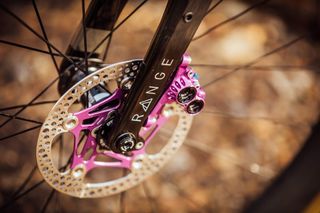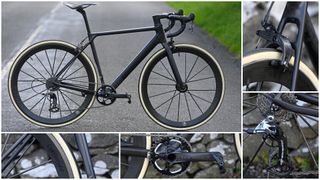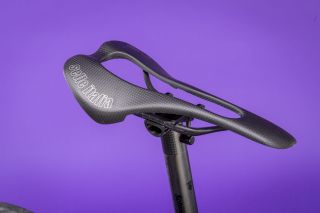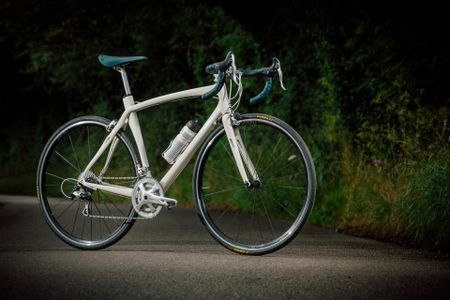The best bike upgrades: where to spend and where to save
Cycling can become an expensive hobby - the art to maximising your pennies is deciding where to spend them


Bike riding can be an expensive hobby if you let it.
The desire to upgrade, to tweak and to improve your bike is one shared by many cyclists. Knowing when to stop can be difficult, and is made harder still by an industry that is regularly touting the next best piece of equipment that will revolutionize your riding.
Of course it doesn’t have to be this way, and more expensive doesn’t always translate to more fun, as shown by the reviews featured in our guide to the best cheap road bikes.
But upgrades can make a difference and there are certainly some areas where the gain is likely to be much greater than others...
Which bike upgrades are worth the spend?
Looking to choose upgrades that will make a big difference? These are the ones we would recommend.
Frame
It is better to buy one bike frame and have it last you a decade or more than it is to buy a new bike every three years - both from a pocket orientated and sustainability perspective.
Investing in your frame doesn't necessarily mean buying the latest and greatest. Make sure you're choosing a frame with geometry that suits you. Look for 'standard' standards, too - a lot of frames with proprietary components promise aero savings but you're stuffed if you want to replace the seat post only to find it's out of production.
The surest bet here? Find a frame builder you trust and buy a custom frame. The time investment is much greater, and the cost will be higher than buying an entry-level frame from a big player - but shop around and custom frames don't have to be more expensive than mid-range off-the-peg options.
For example, custom geo on an Isen steel bike adds just £380 / $465, with frames from £2990 / $3675. Going custom means you're far more likely to be entirely satisfied with the result - greatly reducing the chance of a trade in a few short years down the line.
Finally, if you're going to invest in a dream frame, it might be worth adding one more little extra hurdle en route to perfection by getting it faced before you build it up. Your components may thank you.
Tires

Assuming you're riding on a smooth, flat piece of road at 40kph, rolling resistance makes up about 20 per cent of the total energy you're putting into the bike. The rest is accounted for by aerodynamic drag (70 per cent most of which is you) and drive train friction (10 per cent). On rougher surfaces, rolling resistance has an even greater impact.
Your tires also play a pivotal role in rolling resistance, as well as comfort. More supple compounds smooth out the bumps below you and offering more grip in the corners.
Aeightbike's Glen Whittington has worked in multiple workshops, and has been the mechanic to several pro teams. He put tyres high up on the 'spend' agenda, as well as a consideration for what's inside them: "For me, the very first thing I would consider is tyres, but also tubes and tubeless. A supple tyre will pay you back a million times over as it reacts quickly to the ground beneath you to improve comfort, speed and grip. Ask any proper crit racer if they'd like more front end grip or a lighter bike and they'll pick grip, every time.
"Don't forget about tubes - the best tyre needs to deform and reshape itself thousands of times a minute, butyl tubes create friction between the tyre and the tube and at high pressure they don't allow the tyre to deform and move around - the new generation of lightweight and latex tubes reduce this issue and save considerable rotational weight - even better go tubeless and completely remove the problem."
Tires do contribute a fair amount towards a bike's overall weight. The Continental Grand Sport Race (£30 / $40 per tyre or £60 / $80 per bike) is a fairly common stock tyre, and a 28mm model has a claimed weight of 330g.
Upgrade to the German brand's Grand Prix 5000 (clincher) in the same width and you'll save almost 100 grams per tyre. However, this does come with a higher price tag (£65 / $80 per tyre or £130 / $160 per bike) in the same width. "Once you've experienced lightweight tyres you won't go back," Whittington said.
Wheels

Many bikes retailing below $3,000 / £2,500 (and quite a few over that figure) come with entry-level stock wheels, and all of our Cycling Weekly testers will confirm that swapping these for a pair of the best road bike wheels can drastically improve ride quality.
However, this is an area where there is a very clear point of diminishing returns. It can be tempting to build up a 'wheel library' of hoops for all occasions, but we'd advise most riders to find a middle ground and stick with it.
Starting with rim depth, Parcours' Dov Tate has completed extensive testing and found that the difference between a box section alloy rim and a 40mm Parcours Grimpeur wheelset comes in at 22.9 watts, all things being equal when running the Chrono 77mm front/86mm rear pair the gain is 29.7 watts. So - there is a big gain to be had by upgrading from a box section to mid-section rims - but the benefit of going deeper sits at around 6 watts.
Similarly, a super lightweight wheel will feel amazing, but the actual increase in speed is questionable, "if you run the numbers you literally have to climb Alpe d’Huez or equivalent before weight becomes more important [than aerodynamics],” Tate told us.
The 'middle ground for most' viewpoint is one that Aero Lead and Senior R+D Engineer at Specialized, Mio Suzuki shared, telling us: “Having evaluated many leading brands’ wheels and having designed some in my bike-industry career, my recommendation for performance or race-focused consumers would be 40mm-50mm wheels. But, if a consumer is weight conscious, and doesn’t like the feel of handling the deeper rim wheels, then 32mm is a good choice.”
When it comes down to how much to spend - there are some excellent options around the $1,500 / £1,100 mark, the Parcours' Strade being a good example.
Whittington is all for finding a local wheel builder, adding: "If you want a really nice set of handbuilts expect to pay around £600-£800, and then the next step up would be a carbon wheel. Carbon wheels again aren't specifically aimed at being lighter, it's much more about better aerodynamics, so don't be put off by a wheel that is fractionally (50/100g) heavier if it's superior in terms of aerodynamics."
Seatposts

A lot of work (some of it not entirely successful) has gone into creating flex at the seatpost in recent years. That's because whilst brands are still chasing the superlative in stiffness when it comes to the areas of the frame which flex under load, riders need compliance or fatigue will set in before they've had a chance to make the most of that awesome power transfer. The seatpost (alongside tires) is one area where comfort can be maximised without sacrificing frame stiffness.
Directly comparable data is frustratingly hard to come by without employing an external testing facility or investing in some equipment most magazines don't have. However, countless tests have shown that carbon seatposts provide greater deflection and vibration dampening when compared with aluminum options, and that you'll get a lot more flex here than you ever will out of a frame.
"A carbon seatpost is definitely a worthwhile investment - anyone looking to ride a 100 miles or more will not regret it," Whittington reported. "The flex in the seatpost has allowed frame builders of all kinds to vastly improve the efficiency of the drivetrain without sacrificing the rider comfort by isolating the two things from one another."
Brakes

"One of the best ways to make a rider faster on a descent is to give them better brakes" - the guy in a local bike shop I used about 10 years ago. I'm sure this quote is not unique to said bike shop owner, and that's because it's very true.
"The techy reason why [quality brakes are so] important is if you can apply more brake power for a shorter time, and modulate that power, then you'll cover the ground more quickly," Whittington says. "Probably the more important reason is that better brakes will improve your confidence as a rider - without knowing why you'll get faster and faster because you're more confident about what your bike can handle, and if you need to get out of trouble, you won't already be on the limit."
"I haven't really used anything less than [Shimano] 105 for a long time now - anything from that pricepoint upwards will certainly improve a budget bike."
If you want to really maximise performance, check out some of the upgrades available from brands like Hope. At last test we awarded the RX4 a perfect 10/10. This features a four piston design as opposed to the usual two, and machining the caliper from a single billet of aluminium reportedly makes for a lighter and stiffer product.
This doesn't just apply to the caliper (rim or disc), but the pads also. The last time I tested a bike that came specced with a Shimano Tiagra non-cartridge shoe/pad combination, I swapped these for a Shimano Ultegra shoe and pad - the outlay was £46 / $56 but I found this resulted in a dramatic drop in braking distance.
Whilst we're on the groupset topic, Whittingham advocates checking out your crankset - and its overall weight: "One note that I'd add is to consider the cranks - I was surprised when I tested a few out just how much perceived difference it makes, how much actual efficiency improved and how much weight could be saved - I swapped the bog standard Shimano OE cranks for SRAM Red 1x and saved nearly 400 grams. It also vastly transformed the experience of riding the bike. I'd say it's as important as brakes, but not quite as critical as wheels and tyres."
Which upgrades offer less value for money?

Now, if you've made these investments - then there's no judgment here, whatsoever. CW's tech team members have no doubt made some of them, too. It's not that we don't enjoy the benefits of these lovely luxuries, we just don't think they offer quite as much bang for your buck.
Handlebars and stems

Carbon handlebars can come in anywhere from 20 to 40 per cent lighter than their aluminum counterparts. Carbon is also more malleable and can be contorted into some inspired wind defeating shapes.
However, the weight difference is minimal and the actual aero saving is questionable. It's arguable that the price difference is disproportionate. An alloy set of bars will cost you around £55 / $70, vs £250 / $250 plus for carbon.
In terms of drag, in a bike/rider unit, the rider makes up in the region of 85 per cent of drag. This can be reduced by narrowing your frontal area - but the cheapest set of aluminum handlebars can do this job provided they're available in the correct size.
“The rider is and always will be the biggest contributor to overall system drag. And the easiest thing a rider can do to reduce drag is reduce their frontal area… Next to rider position, the wheels make the biggest difference in reducing system drag,” Cervelo’s brand manager, Anton Petrov told us.
When working at the Boardman Performance Centre, Head of Science and Tech Development Jamie Pringe told us that the degree to which the aerodynamics of the bike's frame and component profiles matter comes down in part to how optimised the rider is themselves.
“Take a road rider and bike combined, in fairly average and typically unaerodynamic road position. The overall CdA will be high, and bike itself may be only 15 per cent of the total drag,” Pringle told us. “But for the road rider with a well-optimised position, their overall CdA is much lower – but the equipment itself hasn’t changed, so that bike can become 20 per cent of the total system drag" - that percentage increases when we begin to look at already optimised time trial riders.
So, if you've exhausted all avenues in terms of how to reduce your own profile, aero frames and bars will become of higher importance, until then, there may be cheaper savings to be had elsewhere.
Super lightweight components

There are some jaw-droppingly light components available on the market. A prime example is the Selle Italia SLR C59 saddle - which weighs in at just 63g, but will set you back £449 / $599. Unless the feathery caress of carbon across your entire undercarriage is particularly high on your wish list, this one falls into the marginal gains category for us.
Even carbon railed saddles hike the price considerably. For example, the Fizik Luce saddle with alloy rails costs £94.99 / $99.99 vs £164.99 / $199.99 for the carbon option. The weight difference is 56g, so it's not quite as expensive per gram as carbon handlebars, but if you intend to enter into a process of saddle trial and error then the cost will add up. Getting a saddle that suits your physiology is essential to efficient power transfer - we'd always recommend prioritizing finding a shape that works for you over low weight.
Lightweight bottle cages come into this category, too. Carbon versions are far more costly but often the weight difference is negligible.
Upgrade pedals also sit in this category; many top end pedals use the same system as their cheaper counterparts while the difference in material, which hikes the price, is barely discernible.
Ceramic bearings
The moving parts of your bike are full of bearings. Traditionally, these will be made up of steel balls within a metal race. However, it is possible to upgrade to hybrid bearings that use ceramic balls and a metal race, or full ceramic bearings with ceramic races.
According to market leader CeramicSpeed, if you upgrade to ceramic bearings in your hubs, pulley wheels and bottom bracket, its tests show you'll gain "6-9 watts, compared to using standard bearings." You can then fit your bike with a CeramicSpeed UFO Racing chain, and "save between 2–5 watts, taking your competitive advantage up to 14 watts."
Many oversized pulley wheel systems use ceramic bearings. As well as looking cool at the coffee stop these reportedly provide a saving of around 3 watts, due to the greater efficiency in pulling the chain around a larger wheel.
In total, that's 17 watts - assuming everything is running smoothly and well maintained. It's not a saving to be sniffed at, but the costs add up.
"I really do rate ceramic bearings, but it's a huge investment," Whittington told me, "I would look at it as your final investments rather than the place to start. To get the best advantage you really need to replace all six hub bearings, the BB bearings, the pulley wheel bearings and the chain, which can easily set you back £1500 (approx. $1845). For that kind of money, you could buy a very nice set of wheels."
Looking for cheaper wins? CeramicSpeed's own data shows that at 250 watts, a cleaned and lubricated chain will save 4 watts, a further 3 watts can come from avoiding cross chaining whilst the cost of a worn chain is about 2 watts.
Electric shifting

Lekky gears are indeed very nice to have, and we would rather ride them over mechanical. The shifts are smooth and seamless, there's never a clunk to be heard and the hoods are slighter and more ergonomic, particularly for riders of a smaller build.
Up until recently the cost of a replacement rear derailleur remained high, meaning that most of CW's tech team writers were happy to stick with mechanical on our own personal builds.
However with the launch of both Shimano 105 Di2 and SRAM Rival eTap AXS, this is becoming less of an issue. The rear derailleur's still aren't cheap - a 105 rear mech retails at £274.99 / $279.99 and a Rival one lower still at £236 / $269 - but it's an improvement considering they both share many attributes of their more expensive siblings, Dura-Ace and Ultegra and Red and Force respectively. If the trickle down tech trend continues we could soon see electronic shifting on entry level groupsets, such as SRAM Apex.
Bike fits (to an extent)

Being comfortable and efficient on your bike is crucial to your enjoyment and performance, and often having a qualified professional help you to achieve this can result in massive gains. That matter is not in dispute. However, do shop around.
Expensive bike fits, coming in around £400 / $500+, will often be accompanied by the use of fancy lasers and video analysis. These tools can help reassure the customer that they are in the right position once they leave the premises, and granted they are often used by practitioners of fit with excellent knowledge. However, there are many exceptional fitters working in bike shops across the country and charging a lot less. Don't overlook an experienced bike fitter just because they can't promise you a laser show.

Thank you for reading 20 articles this month* Join now for unlimited access
Enjoy your first month for just £1 / $1 / €1
*Read 5 free articles per month without a subscription

Join now for unlimited access
Try first month for just £1 / $1 / €1
Get The Leadout Newsletter
The latest race content, interviews, features, reviews and expert buying guides, direct to your inbox!
Michelle Arthurs-Brennan the Editor of Cycling Weekly website. An NCTJ qualified traditional journalist by trade, Michelle began her career working for local newspapers. She's worked within the cycling industry since 2012, and joined the Cycling Weekly team in 2017, having previously been Editor at Total Women's Cycling. Prior to welcoming her daughter in 2022, Michelle raced on the road, track, and in time trials, and still rides as much as she can - albeit a fair proportion indoors, for now.
-
 The 2027 Tour de France will be within touching distance in the UK - here's what you can expect and when you'll need to book on accommodation
The 2027 Tour de France will be within touching distance in the UK - here's what you can expect and when you'll need to book on accommodationThe Tour de France and Tour de France Femmes avec Zwift will begin on British roads in 2027 - here's everything you need to know
By Adam Becket Published
-
 I can’t wait for the Tour de France to come to the UK, but inspiring a generation will take more than souvenirs and a momentary flash of wheels
I can’t wait for the Tour de France to come to the UK, but inspiring a generation will take more than souvenirs and a momentary flash of wheelsSimply having the men’s and women’s races on British roads isn’t enough to get people into riding and racing
By Adam Becket Published
-
 Five cost-effective upgrades to make a second-hand bike feel like new again
Five cost-effective upgrades to make a second-hand bike feel like new againWe run you through the most cost-effective ways to get a 'brand new' feeling from a second hand bike
By Stefan Abram Published
-
 Data-loving roadie selection: Simon Smythe's Gear of the Year 2022
Data-loving roadie selection: Simon Smythe's Gear of the Year 2022Forget about riding over small stones - cycling is really about producing big numbers, right? Here are 10 things that might help
By Simon Smythe Published
-
 Everything gravel - racing and riding: Anna Marie Abram's Gear of the Year 2022
Everything gravel - racing and riding: Anna Marie Abram's Gear of the Year 2022From the start line to bikepacking epics, these are my top kit picks for 2022
By Anna Marie Abram Published
-
 North American Editor's picks: Anne-Marije Rook's Gear of the Year 2022
North American Editor's picks: Anne-Marije Rook's Gear of the Year 2022From an awesome Craiglist find, to ponchos, CBD, gravel tires and dog leashes, Rook's list is a smörgåsbord of cycling lifestyle items
By Anne-Marije Rook Published
-
 Bikepacking adventure picks: Stefan Abram's Gear of the Year 2022
Bikepacking adventure picks: Stefan Abram's Gear of the Year 2022From the Garmin Edge 1040 Solar and its epic battery life to the perfectly-sized Therm-a-Rest Space Cowboy sleeping bag, these are my top kit picks for 2022
By Stefan Abram Published
-
 Five simple upgrades to get the best out of your gravel bike
Five simple upgrades to get the best out of your gravel bikeHere's how to to push your bike further – and go faster off-road
By Stefan Abram Published
-
 Urban-utility-e-cargo-bike special: Hannah Bussey's Gear of the Year 2022
Urban-utility-e-cargo-bike special: Hannah Bussey's Gear of the Year 2022This year she's been hauling lifestyle changes and a whole lot of happiness in to a new rural life
By Hannah Bussey Last updated
-
 Winter warrior kit picks: Luke Friend's Gear of the Year 2022
Winter warrior kit picks: Luke Friend's Gear of the Year 2022A modern steel road bike, a 3D printed saddle, waterproof gloves and versatile insulated jacket
By Luke Friend Published
